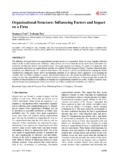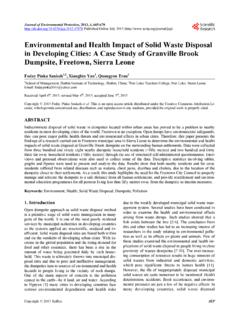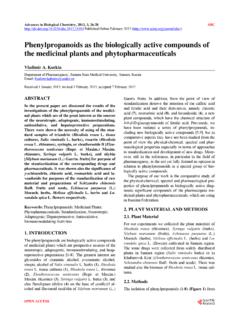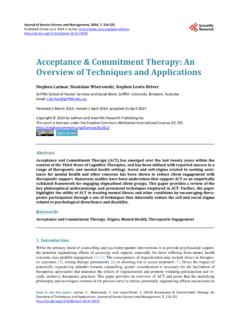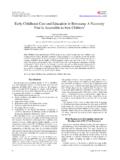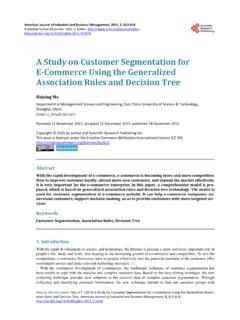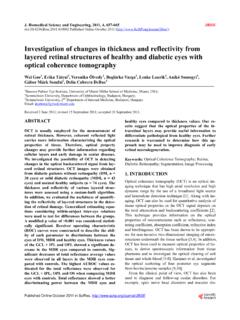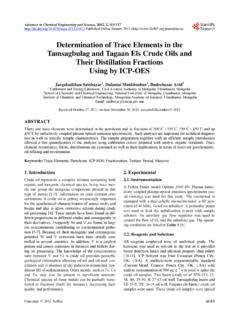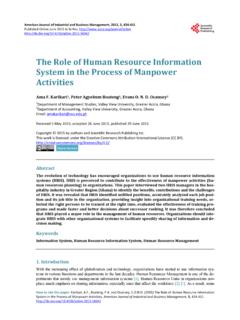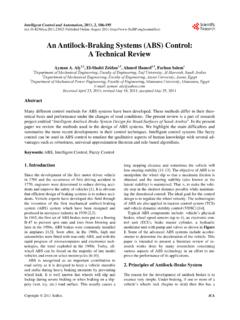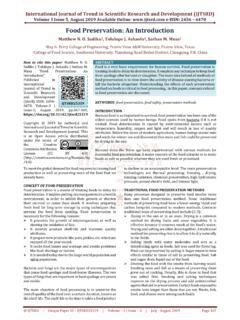Transcription of Starch Based Bio-Plastics: The Future of Sustainable Packaging
1 Open Journal of Polymer Chemistry, 2018, 8, 21-33. ISSN Online: 2165-6711. ISSN Print: 2165-6681. Starch Based Bio-Plastics: The Future of Sustainable Packaging Ravindra V. Gadhave, Abhijit Das, Prakash A. Mahanwar, Pradeep T. Gadekar Department Polymer and Surface Engineering, Institute of Chemical Technology, Mumbai, India How to cite this paper: Gadhave, , Abstract Das, A., Mahanwar, and Gadekar, (2018) Starch Based Bio-Plastics: The Fu- Petroleum derived plastics dominate the food Packaging industry even today. ture of Sustainable Packaging . Open Jour- These materials have brought a lot of convenience and attraction to agro, food nal of Polymer Chemistry, 8, 21-33. and Packaging industry. These materials also have brought along with them problems relating to the safe-disposal and renewability of these materials. Due Received: March 10, 2018 to the growing concern over environmental problems of these materials, in- Accepted: May 27, 2018 terest has shifted towards the development and promoting the use of Published: May 30, 2018.
2 Bio-plastics . Bio-plastic is a term used for Sustainable Packaging materials Copyright 2018 by authors and derived from renewable resources produced from agro/food sources, ma- Scientific Research Publishing Inc. terials such as Starch , cellulose, etc. and which are considered safe to be used This work is licensed under the Creative in food applications. To enhance the mechanical properties, and water barrier Commons Attribution International properties, it can be blended easily with other polymer as well as nano fillers. License (CC BY ). The current paper is a review of the progress of research in Starch Based sus- Open Access tainable Packaging materials. Keywords Bioplastic, Starch , Packaging , Sustainable 1. Introduction Reason for transition from synthetic plastic materials to biobased plastic mate- rials Synthetic polymers or petrochemical- Based plastics like polyamides (PA), ny- lon, polystyrene (PS), Teflon, polyethylene terephthalate (PET), polyethylene (PE) etc.
3 Have been widely used for food Packaging applications due to their ex- cellent thermal and rheological properties, lightweight, easy to manipulate, and install in a diverse range of applications, gas and water barrier properties, es- thetic qualities, and cost [1]. The oil that is used as a raw material, as well as the oil required for energy, consumes between six to eight percent of the total world DOI: May 30, 2018 21 Open Journal of Polymer Chemistry R. V. Gadhave et al. oil production. Although this is a small percentage, the amount of petroleum used to make plastic does contribute to the depletion of fossil fuels. The rate of consumption influences the overall price of petroleum, contributing to the cur- rent rise in raw material costs. Plastics derived from petroleum are made from synthetic polymers [2]. Their utility includes but is definitely not limited to agriculture, aerospace, automobile, construction, sports, domestic, and house- holds.
4 Increase in population and industrial growth have resulted in the in- creased production of synthetic polymers and allied materials [3]. Polyethylene more often used as carry bag and more is produced annually [4]. Non recyclable and synthetic polymeric materials are causing a serious concern in environmen- tal related issues. In particular, the plastic bags which are discarded into the en- vironment have become a menace [5]. Significant quantities of plastic have ga- thered in the natural environment and in landfills. Wasted plastic also contami- nates a wide range of natural terrestrial, freshwater and marine habitats. There are accounts of inadvertent contamination of soils with small polymer fragments as a consequence of spreading sewage sludge [6], of fragments of plastic and glass contaminating compost prepared from municipal solid waste [7] and of plastic being carried into streams, rivers and ultimately the sea with rain water and flood events [8].
5 Most polymers are buoyant in water, and since items of plastic debris such as cartons and bottles often trap air, substantial quantities of plastic debris accumulate on the sea surface and may also be washed ashore. As a consequence, plastics represent a considerable proportion (50% - 80%) of shore- line debris [9]. Phthalates Based plasticizers and BPA can bio-accumulate in organisms, but there is much variability between species and individuals according to the type of plasticizer and experimental purpose. However, concentration factors are generally higher for invertebrates than vertebrates, and can be especially high in some species of molluscs and crustaceans. Plastics contain phthalates, BPA, flame retardants, cadmium, lead and organo tins, all of which have been shown in animal studies to result in obesity [10]. In addition, the monomer used to manufacture PVC plastic, vinyl chloride, is a known carcinogen and exposure can cause angiosarcoma of the liver among factory workers [11] [12].
6 In recent decades, the plastic industry and the academic community have been together looking for new raw materials to replace the petrochemical poly- mers, which are produced from nonrenewable resources [13]. Biodegradable plastic made from renewable resources is decreases dependence on petroleum and reduces the amount of waste material, while still yielding a product that provides similar benefits of traditional plastics [14]. The major dif- ference between synthetic polymers and natural polymers is that the presence of oxygen and nitrogen in the natural polymers. The oxygen and nitrogen in the polymer structure permit the polymer to biodegrade [15]. Bio- Based polymers have been shown to be a viable alternative to replace these fossil sources while also having environmental advantages, such as decreasing toxic emissions [16].
7 DOI: 22 Open Journal of Polymer Chemistry R. V. Gadhave et al. Most traditional plastics are inert to microbial attack, and the development of biodegradable Packaging , these derived from renewable natural resources, has gained increasing interest [17]. Target markets for biodegradable polymers in- clude Packaging materials like trash bags, loose-fill foam, food containers, film wrapping, laminated paper, hygiene products like diaper back sheets and cotton swabs, consumer goods like fast-food tableware and containers, egg cartons, and toys, and agricultural tools like mulch films and planters etc. [18]. Cellulose, lignin, and Starch are commonly available in nature. Cellulose is abundant in all plants, although some plants produce more than others. Lignin is typically found in wood, and Starch is common in plants such as corn, potatoes, and wheat.
8 Plants, wood, corn, potatoes, and wheat are all raw materials that are renewable, biodegradable and easily available [19]. Packaging materials with biodegradable plastic is more expensive than traditional petroleum Based plastic. Packaging materials Based on these natural materials may be a solution to help control the environmental pollution and resolve other problems posed by non-degradable synthetic polymers [20]. 2. Biodegradability and Compostability Bio- Based is defined in European standard EN 16575 as derived from biomass . Biodegradable materials are materials that can be broken down by microorgan- isms like bacteria or fungi into water, naturally occurring gases like carbon dio- xide (CO2) and methane (CH4) and biomass. Biodegradability depends strongly on the environmental conditions: temperature, presence of microorganisms, and availability of oxygen and water [21] [22].
9 Compostable materials are materials that break down at composting condi- tions. Industrial composting conditions require elevated temperature (55 C - 60 C) combined with a high relative humidity and the presence of oxygen, and they are in fact the most optimal when compared against other degradation con- ditions like in soil, surface water and marine water. Compliance with EN 13432. is considered a good measure for industrial compostability of Packaging mate- rials. According to the EN13432 standard, plastic Packaging can only be called compostable [23]. 3. Bioplastic as Packaging Material Polylactic acid (PLA): Polylactic acid (PLA) is a 100% bio- Based plastic that is currently being used in Packaging applications. PLA is very suitable for the manufacture of compostable Packaging products. Specific benefits of PLA in Packaging applications are its transparency, gloss, stiffness, printability, process ability and excellent aroma barrier.
10 PLA is approved for direct contact with food and is applied in a range of Packaging products. PLA is frequently used in com- bination with other bio- Based and biodegradable polymers to improve stiffness and strength and to reduce costs. Cellophane: Cellophane films are highly transparent, and stiff. Cellophane DOI: 23 Open Journal of Polymer Chemistry R. V. Gadhave et al. films can be colored and are well known as candy wrappings. The biodegradable films are available in a wide range of grades, and they can be used to pack prod- ucts ranging from cheese to coffee and chocolate. Cellulose acetate: When extensively modified, cellulose can become thermop- lastic. An example is cellulose acetate. This material is rather expensive and rarely used in Packaging applications. The most frequently used biodegradable polyesters are polybutylene adipate terephthalate (PBAT), Polycaprolactone (PCL) and Polybutylene succinate (PBS).
